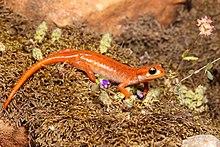| Luschan's salamander | |
|---|---|
 | |
| Scientific classification | |
| Kingdom: | Animalia |
| Phylum: | Chordata |
| Class: | Amphibia |
| Order: | Urodela |
| Family: | Salamandridae |
| Genus: | Lyciasalamandra |
| Species: | L. luschani |
| Binomial name | |
| Lyciasalamandra luschani (Steindachner, 1891) | |
| Synonyms[2] | |
| Molge luschani Steindachner, 1891 | |
Luschan's salamander or Lycian salamander (Lyciasalamandra luschani) is a species of salamander in the family Salamandridae. It is found in the southwestern Anatolia in Turkey and in adjacent Greece (the island of Kastellorizo and its satellites).[1][2]
Description
Luschan's salamander is brown with small yellow dots dorsally, yellow or whitish laterally, and flesh-colored ventrally. The eyes are prominent, as are the narrow paratoid glands. The tail is thin. Males have a protruding "spike" at the base of their tails on the dorsal surface. Adults may grow to 13 cm (5.1 in) in total length.[3]
Reproduction
Luschan's salamanders are viviparous. Females give birth to two offspring that are produced from each of the female's two oviducts. Gestation time ranges from 5-8 months.[4]
Habitat and status
Its natural habitats are temperate forests and Mediterranean-type shrubby vegetation. It is threatened by habitat loss.
Subspecies
The three subspecies are:[2][5]
- L. l. basoglui (Baran & Atatür, 1980)[6][7]
- L. l. finikensis (Basoglu & Atatür, 1975)[6][7]
- L. l. luschani (Steindachner, 1891)[6][7]
References
- ^ a b Lymberakis, P.; Kaska, Y.; Kumlutaş, Y.; Avci, A.; Üzüm, N.; Yeniyurt, C.; Akarsu, F.; Tok, V.; Ugurtas, I.H.; Sevinç, M.; Crochet, P.-A.; Papenfuss, T.; Sparreboom, M.; Kuzmin, S.; Anderson, S. & Denoel, M. (2009). "Lyciasalamandra luschani". IUCN Red List of Threatened Species. 2009: e.T41241A86525768. doi:10.2305/IUCN.UK.2009.RLTS.T41241A10422896.en.
- ^ a b c Frost, Darrel R. (2018). "Lyciasalamandra luschani (Steindachner, 1891)". Amphibian Species of the World: an Online Reference. Version 6.0. American Museum of Natural History. Retrieved 7 June 2018.
- ^ Arnold, E.N and J.A. Burton. 1978. A Field Guide to the Reptiles and Amphibians of Britain and Europe. Collins. London ISBN 0002199645.
- ^ Vitt, Laurie J.; Caldwell, Janalee P. (2014). Herpetology: An Introductory Biology of Amphibians and Reptiles (4th ed.). Academic Press. p. 169.
- ^ Veith, Michael & Steinfartz, Sebastian (2004). "When non-monophyly results in taxonomic consequences – the case of Mertensiella within the Salamandridae (Amphibia: Urodela)" (PDF). Salamandra. 40 (1): 67–80. ISSN 0036-3375. Archived from the original (PDF) on 2013-09-21.
- ^ a b c Budak, A. & Göçmen, B. (2005). Herpetology. Ege Üniversitesi Fen Fakültesi Kitaplar Serisi, No. 194, Ege Üniversitesi Basimevi, Bornova-Izmir
- ^ a b c (in Turkish) Bayram Göçmen Archived 2012-12-21 at Archive.today. Fen.ege.edu.tr. Retrieved on 2013-01-03.
